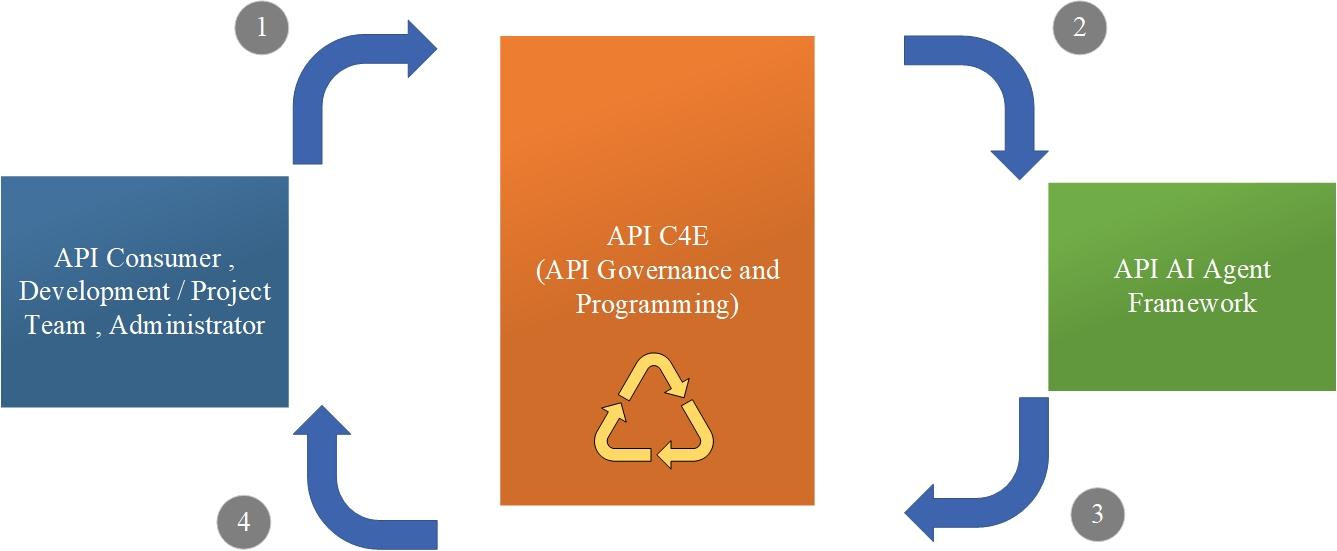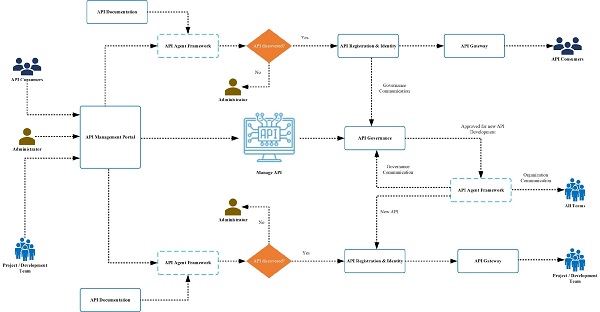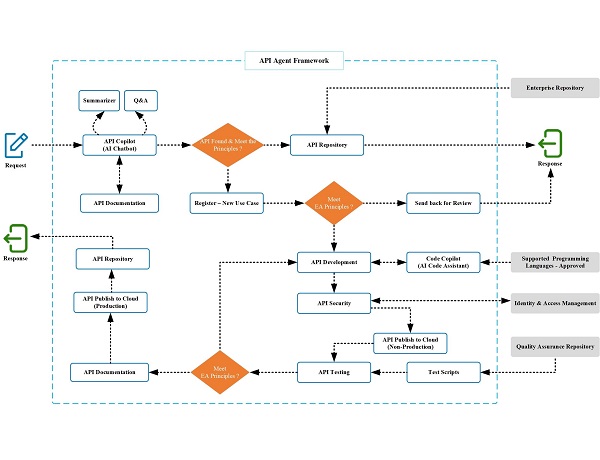Ijraset Journal For Research in Applied Science and Engineering Technology
- Home / Ijraset
- On This Page
- Abstract
- Introduction
- Conclusion
- References
- Copyright
API C4E Augmentation: AI-Powered Agent(AIPA) Framework
Authors: Mahendhiran Krishnan
DOI Link: https://doi.org/10.22214/ijraset.2024.65267
Certificate: View Certificate
Abstract
In today’s rapidly evolving digital landscape, organizations increasingly rely on Application Programming Interface known as API for seamless integration and data exchange. API providers comprising consumers, developers, and project teams face several challenges in discovering, developing and mapping APIs in compliance with organizational enterprise architecture principles. This paper aims to address these challenges by proposing an AI-Powered Agent (AIPA) Framework that leverages Generative AI and AI Code Assistant tools to enhance API governance and streamline the API development cycle (API Management, develop API, testing, security, deployment and monitoring). The proposed framework facilitates API discovery through an interactive chat interface that summarizes available APIs based on the use case. Additionally, it aims to automate key aspects of API development, including compliance checks, security protocols, and document generation thereby significantly reducing effort(s), human error(s), and improving productivity and efficiency. Establishing an API Center for Enablement (C4E) ensures consistent adoption of best practices across the organization. By integrating AI-driven solution with API governance, this paper outlines a pathway for organizations to improve API quality, security, and usability while empowering to adapt to digital disruptions. The findings suggest that a comprehensive, AI-enhanced governance framework enhances operational and development efficiency and fosters innovation.
Introduction
I. INTRODUCTION
Application Programming Interface (API) facilitates data exchange and integration between the applications. APIs are typically developed within the organization however, there are publicly available APIs that are accessible over the internet. To ensure consistent practices across the enterprise, organizations often implement and execute API governance by the enterprise governance and architecture teams to enforce compliance.[1]
Organizations with multiple Lines of Business (LoB) allow API developers to use various technologies like Python, C#.Net, Java, etc., to meet specific business of Information Technology (IT) requirement(s). With the increasing demand for APIs, the organization faces challenges, as listed below
- Duplicate APIs due to limited visibility across LoB.
- Frequent disruptions from evolving technology and business needs.
- Complexity in managing APIs effectively.
The API Center for Enablement (API C4E) will be a cross-functional team responsible for establishing standards, guidelines, best practices, and governance to ensure consistency and enhance API quality across LoBs. The API C4E team helps run the API platform and educates teams on developing reusable APIs. However, API providers still struggle to identify existing APIs, meeting access and identity policies, and complying with governance, which can lead to schedule slippage.
Confronting these issues, this paper proposes an AIPA framework using GenAI and AI-Powered code assistants. This framework aims to simplify API management, improve accessibility, and support governance, enabling efficient API development aligned with enterprise policies.
II. BACKGROUND
This section provides a solid foundation for understanding the concepts and framework surrounding API management, discovery, API development, testing, security, deployment, monitoring, and governance. Each sub-section aligns with how an AIPA framework will augment API C4E and could significantly enhance API lifecycle through automation and intelligent assistance, leveraging Gen AI to improve efficiency, accuracy, and security.
A. API Discovery on use case basis
Organizations often manage thousands of APIs to enable complex applications to integrate and exchange data. The API C4E framework provides for API discovery. However, API providers comprising consumers, developers, and project teams struggle to identify the existing API that meets their specific use case or their requirements. Although most APIs are documented with use and implementation steps, they are often not mapped directly to specific functionalities or use cases, complicating the discovery process.[2][3][4].
In this paper, I propose an AIPA framework solution that provides an interactive chat interface to assist API providers in finding relevant APIs. This AIPA framework offers API summaries and answers to specific questions (user prompts) about the APIs. Using GenAI, the summarizer and chatbot are pre-trained on API documentation and repositories. Employing Retrieval-Augmented Generation (RAG) techniques and prompt engineering, the models are trained information, such as usage instructions, related APIs, implementation steps, platform capabilities, and environment specific details. If no is API discovered for a given use case, AIPA framework communicates the use case to the API administrator and governance team to initiate the development cycle for a new API.
B. API Development Cycle Management
API development typically follows several stages – plan, design, develop, test, deploy and review (enterprise and security architecture teams). Each step must align with enterprise architecture and security guidelines. Manual coding [5][6][7][8] and managing APIs is time-consuming and demand oversight and governance to adhere to enterprise guidelines. Additionally, changes in business needs, technology, and platforms increase organizational effort, cost, and project timelines.
To streamline this process, I propose an AIPA framework that leverages GenAI code assistant tools to automate API development task.[5][6][7][8]. This tool can provide a Minimal Viable Product (MVP) for APIs, execute testing based on the predefined scripts and data, enforce organizational identity (authentication) and access policies (authorization), and automate deployment through DevSecOps pipelines. Furthermore, an AIPA framework creates or updates API documentation, ensuring that all relevant information, including API style, guidelines, and principles, is accurately reflected.
The pre-trained AI models used in an AIPA framework can also be further fine-tuned to context-specific based on organizational standard guidelines and principles. This helps to deliver high-quality APIs with consistent documentation, minimal language errors, and adherence to organizational best practices.
C. API Security
API security is essential to safeguard organizational data, ensuring compliance, and preventing unauthorized access. As API often servs as the entry point for external and internal applications, any security vulnerabilities can result in data breaches, privacy violation, and reputational damage. API security covers multiple areas, including authentication, authorization, data encryption, rate limiting, logging, and continuous monitoring. [9][10].
The pre-trained AI models used in the AIPA framework can also be further fine-tuned by organization enterprise security principles and guidelines. Aligning security solutions with an API management framework can strengthen API security through predictive thread modelling and anomaly detection. By analyzing historical data, an AIPA framework can identify unusable traffic patterns, potential attack points, and new threats. Furthermore, an automated AIPA framework can handle dynamic updates to security policies, thus enabling more responsive and adaptive protection mechanisms.
D. API Deployment, API Testing, Monitoring and Logging
Using Continuous Integration (CI) and Continuous Deployment (CD) pipelines for API deployment is essential in modern software development, enabling faster, more reliable releases with less risk of human error. Integrating APIs into CI/CD pipelines automates deployment of APIs, ensuring quick and consistent delivery across environments and helping organizations maintain high-quality, securely deployed APIs.[11]
Continuous Integration (CI) processes the frequent integration of new code into the main codebase through automated builds and tests. For APIs, this automated testing (unit and functional testing to validate API functionality), code quality static analysis and version control.[12]
Continuous Deployment (CD) process automates releasing validated API changes to production. Steps include staging and validation, deployment automation, and Blue-Green or Canary deployments to minimize risks.[12].
Monitoring and Logging are critical to detect and resolve post-deployment issues, automated alters and notifications (real time monitoring and alerts notify teams of issues example traffic spikes, errors, or latency increases), and performance & usage analytics (track API performance, usage patterns, and potential bottlenecks), providing insights that can be used to optimize API performance over time.[13]
An AIPA framework, integrated with enterprise CI/CD pipelines, can further enhance CI/CD processes by predicting deployment risks, detecting anomalies, and automated troubleshooting. By analyzing historical deployment data, AIPA can identify the patterns, implement optimal release times, and automatically roll back if needed.
E. API Documentation
API documentation functions as the intermediary between consumers / developers / project teams and users of APIs. It provides guidance on how to use, integrate, identity, access details, and troubleshoot APIs. Developing effective API documentation can be difficult and time-consuming, inconsistent use of language, omission of information, particularly when working with complex dynamic, or evolving APIs that require ongoing maintenance.[14][15]
An AIPA framework can assist in automating and enhancing various elements of the API documentation process. The content is based on the analysis and outline of APIs, writing descriptions, essential information about the API endpoint details, API methods, request/response payload formats, authentication methods, and available parameters with detailed explanations. AIPA framework also document other technical specifications such as contextual information, use cases, best practices, and guidelines.
F. API C4E Governance
API governance establishes policies, guidelines, and best practices to ensure APIs are secure, compliant, efficient, and aligned with organization’s IT strategy. With increasing adoption of APIs, a strong governance strategy is essential for consistency, quality, and risk mitigation.[16][17][18]
API Center for Enablement (API C4E) is a cross-functional team within the central IT team, to establish API governance. Key aspects of API governance include:
- Standardization of API Design: Establishing design standards for naming conventions, versioning, documentation, and error/exception handling ensures API are consistent, easy to understand, and integrate. Common practices including adhering to design principles and using consistent naming and versioning strategies.
- Security Policies and Compliance: API governance includes establishing security and compliance standards to protect API against unauthorized access, data breaches, and other security threats. Policies may encompass requirements for authentication & authentication requirements, data privacy and compliance, rate limiting, and throttling policies.
- Lifecycle Management and Versioning: API lifecycle management involves establishing processes for developing, testing, deploying, and retiring APIs. Effective governance specifies lifecycle stages and transition guidelines, deprecation/sun setting policies, and versioning policies.
- Documentation Standards: Quality documentation is essential for API usability and governance ensures that documentation is complete, accessible, and contemporary.
- Monitoring and Analytics: Real-Time and analytics are crucial to maintaining API performance, security, and compliance.
An AIPA framework augments API governance by automating and enforcing governance standards. For instance,
- Policy Enforcement: Scan API codebases and configurations to ensure compliance with governance policies, flagging non-compliant code or configuration changes in real-time.
- Anomaly Detection in Usage Patterns: Monitor usage patterns and detect anomalies, such as unusual traffic spikes or unauthorized access attempts, which could indicate potential security risks.
- Automated Documentation Generation: Helps to maintain up-to-date API documentation by automatically generating and update the documentation from code, reducing manual efforts and ensuring accuracy.
III. APPROACH
In this section, I present a detailed approach, and the steps involved. API C4E governs the API lifecycle consumed / maintained by API providers comprising consumers, developers, project teams, API administrators, and the Architects. An AIPA framework integrates into API C4E to support essential steps including API discovery, API management, development, testing, deployment, and governance, improving efficiency and compliance. [Fig.1]

Fig.1 Overview of AIPA Framework
Fig.2 and Fig.3 depict the API providers comprising consumers, developers, project teams, API administrators, and the architects can access the API management portal which is managed by API administrators and Governance team to check API availability in the organization API repository search by using AIPA framework. API providers can use AIPA framework provided chatbot to send their specific use case or specific API details.

Fig.2 Complete view of AIPA Framework

Fig.3 Detailed view of AIPA Framework
A. API Found
If an AIPA framework identifies a user-provided use case or exact API details, it will summarize the API details including purpose, background, objective, steps to consume, sample request and response payload, and security requirements (authentication and authorization). An API provider can interact with the summarizer to obtain this response. If the user decides to proceed to consume the available API, the AIPA framework validates the API against enterprise principles and guidelines. [Fig.2]
- If the API meets the criteria, the AIPA framework registers for identity, grants access, and automatically provides the complete API package which includes endpoints, encrypted identity details, and API documentation. It also notifies the API governance team with the requestor’s details for auditing and logs for monitoring and analytics. [Fig.2]
- If the API does not meet the criteria, AIPA framework informs the API provider, who can choose to search for other use cases or revise the details submitted earlier. [Fig.2]
B. API Not Found
If an AIPA framework does not find existing API matching the user’s request, it considers a “New Use Case” and initiates the API governance process to validate the request against the enterprise principles before starting the API development process. [Fig.3]
- If the use case meets the criteria, AIPA framework notifies the user of the API’s unavailability and requests for additional details such as programming languages to develop API, security levels, cloud environments, and test case documents via AIPA framework provided chatbot. Once details are collected, AIPA framework will follow the below API development process. [Fig.3]
- API Development: An AIPA framework sends the use case to an organization enterprise-level approved AI Code Assistant – Code Copilot tool (example GitHub Copilot, Tabnine, CodeShisperer, Codeium, etc.,) to generate API code based on the API provider’s required programming language (example Python, C#.Net, Java, etc.,) and code versioning to the enterprise code repository(s) followed by organization’s enterprise-level code versioning strategies. It helps anyone in the organization can use it. [Fig.3]
- API Testing: Using the API providers provided or organizational standard test cases, AIPA framework performs unit and functional testing to verify the use case and generate a Minimal Viable Product (MVP). Enhancements / fixes to this MVP can then be is sent to AI Code Assistant tool for reinforcement learning. [Fig.3]
- API Security Implementation: After API validation, AIPA framework enforces organizational security standards, implementing appropriate API authentication (example oAuth, API key, etc.,) and authorization measures, adapting security policies dynamically as needed and update these credentials in API configuration. [Fig.3]
- API Deployment: Following the validation and security measures, AIPA framework initiates API deployment and automatically triggers an approval workflow, in compliance with deployment principles. If approved, stakeholders received a notification for deployment activities. [Fig.3]
- End-To-End Testing: Post-deployment, AIPA framework validates the API functionality with security credentials, using similar procedure to those in API testing. [Fig.3]
- API Documentation & Repository: Once End-To-End testing is successful, AIPA framework creates the API document includes human-readable instructions for using and integrating within API, API endpoints, methods, resources, authentication protocols, authorization details, parameters, headers, sample request and response payload, steps to consume and is added to the repository.[Fig.3]
- API Response: An AIPA framework sends the complete API package and log details to requestor and notifies the API governance team for auditing, monitoring and analytics purposes. [Fig.3]
- An AIPA framework registers for identity, grant access, and automatically provides the complete API package which includes endpoints, encrypted identity details, and API documents. It also notifies the API governance team with the requestor’s details for auditing and logs for monitoring and analytics. [Fig.3].
- If the use case does not meet the criteria, AIPA framework informs the API providers, who can choose to search for other use cases or revise the details submitted. [Fig.3]
API providers can access API Management Portal to search for any existing API by using AIPA framework’s Knowledge Bot to
- Enable one-to-one self-service for keywords
- Surf knowledge base articles to answer frequently asked questions
- Understand the existing APIs developed by the organization which helps to preserve valuable insights and knowledge that team accumulate over the time.
IV. METHODOLOGY
The below methodology outlines a step-by-step that organizations can follow to establish effective API governance and development cycle using the AIPA framework. The following will help to train the model(s) used for building AIPA framework.
- Define Governance Objectives and Scope: Start by identifying key governance objectives, such as ensuring security compliance, standardizing API design, and improving API usability. Determine the governance scope by identifying which APIs (internal, external or both) will be governed. Engage key stakeholders from development, security, compliance, and operations team to define the governance needs and identify the cross-functional requirements.
- Establish API Design Standards: Standardize the API design principles, including naming conventions, versioning, documentation, and error / exception handling. Define the documentation standards include endpoints details, data format, request / response payload structures, and authentication methods. Design a review process to verify that new APIs meet organizational design standards before they are deployed.
- Implement Security Policies: Define security policies for authentication and authorization using OAuth, Json Web Token, or API keys, depending on the API type and sensitivity. Specify the encryption standards (example Transport Layer Security for data in transit, encryption at rest using AES-256 (Advanced Encryption Standard) algorithm) and ensure compliance with relevant data privacy regulations. Set thresholds for request rates to prevent abuse and manage resource usage effectively, integrating rate limiting into the API gateway or via firewall.
- Develop Lifecycle Management and Versioning Policies: Define clear lifecycle management stages (example development, testing, staging, production, deprecation) with criteria for each transition. This ensures consistent progression through stages and prevents premature deployments. Establish a versioning strategy (example semantic versioning) to guide incremental or major updates for API consumers. Develop a deprecation policy that includes timelines, notifications, and support for legacy versions to help users adapt smoothly.
- Automate CI/CD Process: Embed governance within CI/CD pipelines to automate compliance checks for security, design standards, and versioning. Automate security, testing (functional, performance and security testing), and configure automated deployment for approved versions.
- API Documentation: Leverage API documentation tools like Swagger to generate and update API documentation directly from code, ensuring consistency and accuracy.
The outcome of this proposed methodology allows organizations to establish scalable, secure and well-governed API environments. It ensures that API meet organizational standards, adhere to security protocols, and provide consistent quality, ultimately enhancing API usability and customer / developer / project team trust.
V. RESULT AND DISCUSSION
An AIPA framework is aimed at transforming API management and governance by automating and standardizing routine key tasks like documentation, API development, testing, security, deployment and consumption guidelines. This will increase efficiency and improve productivity significantly.
- API Discovery: API providers access the API Management Portal to discover APIs using the AIPA framework chatbot. The chatbot aids in searching the API repositories and provides relevant API information.
- API Development Cycle: An AIPA framework chatbot summarizes the API details if API is discovered. Once approved by Enterprise Governance, it registers and grants access by validating compliance with enterprise guidelines. In case criteria are unmet then it will be rejected, and API providers comprising consumers, developers, and project teams can revise their request. If API is not discovered, for new use case, the request is flagged for API governance. Upon meeting the guidelines, the chatbot give users through API development cycle. API Development Cycle (Development, Testing, Security, Deployment, End-To-End testing and API Documentation) will be automated via AIPA framework.
- API Governance: API requests are audited for compliance, with logs maintained for monitoring and analytics. The AIPA framework communicates access details to API governance for auditing purposes.
- Knowledge Management: The API Management Portal allows users to search and understand existing APIs, preserving organizational knowledge, reducing setup time, and expediting API discovery.
Conclusion
API Governance is essential for modern organizations that rely on APIs to enable integration, data exchange, and digital transformation. As API demand grows, so do the challenges associated with maintaining consistency, security, and quality across a vast and diverse API ecosystem. Effective governance provides a structured approach to address these challenges, establishing standards, enforcing security protocols, and ensuring alignment with enterprise architecture principles. By implementing a robust governance framework, organizations can create APIs that are not only secure and compliant but also efficient and user-friendly. This paper’s proposed solution – API C4E Augmentation: AI-Powered Agent (AIPA) framework, incorporating a CI/CD pipeline for automated compliance, API development lifecycle management, facilitating policy enforcement, real-time monitoring, anomaly detection, and documentation automation, reducing human effort and enhancing accuracy. The formation of an API C4E further ensures cross-functional alignment, promoting best practice and fostering a collaborative environment across business lines.
References
[1] Rediana Koçi, Xavier Franch, Petar Jovanovic, Alberto Abelló, Web API evolution patterns: A usage-driven approach, Journal of Systems and Software, Volume 198, 2023, 111609, ISSN 0164-1212, https://doi.org/10.1016/j.jss.2023.111609. [2] Kuat Yessenov, Ivan Kuraj, and Armando Solar-Lezama. DemoMatch: API discovery from demonstrations. SIGPLAN Not. 52, 2017, 64–78. https://doi.org/10.1145/3140587.3062386 [3] Michael B. James, Zheng Guo, Ziteng Wang, Shivani Doshi, Hila Peleg, Ranjit Jhala, and Nadia Polikarpova. Digging for fold: synthesis-aided API discovery for Haskell. Proc. ACM Program. Lang. 4, OOPSLA, 2020, 27 pages. https://doi.org/10.1145/3428273 [4] R. Torres, B. Tapia and H. Astudillo. Improving Web API Discovery by Leveraging Social Information. IEEE International Conference on Web Services, Washington, DC, USA, 2011, pp. 744-745, doi: 10.1109/ICWS.2011.96 [5] A. C. Rajeev, Prahladavaradan Sampath, K. C. Shashidhar, and S. Ramesh. CoGenTe: a tool for code generator testing. In Proceedings of the 25th IEEE/ACM International Conference on Automated Software Engineering (ASE \'10). Association for Computing Machinery, New York, NY, USA, 2010, 349–350. https://doi.org/10.1145/1858996.1859070 [6] M. A. Wehrmeister, E. P. Freitas, C. E. Pereira and F. Rammig, \"GenERTiCA: A Tool for Code Generation and Aspects Weaving,\" 2008 11th IEEE International Symposium on Object and Component-Oriented Real-Time Distributed Computing (ISORC), Orlando, FL, USA, 2008, 234-238, doi: 10.1109/ISORC.2008.67 [7] R. Campos-Rebelo, F. Pereira, F. Moutinho and L. Gomes, From IOPT Petri nets to C: An automatic code generator tool, 9th IEEE International Conference on Industrial Informatics, Lisbon, Portugal, 2011, pp. 390-395, doi: 10.1109/INDIN.2011.6034908. keywords: {Petri nets; Fires; Microcontrollers; Data structures; Semantics; Humans} [8] Amnell, T., Fersman, E., Mokrushin, L., Pettersson, P., Yi, W. TIMES: A Tool for Schedulability Analysis and Code Generation of Real-Time Systems. In: Larsen, K.G., Niebert, P. (eds) Formal Modeling and Analysis of Timed Systems. FORMATS 2003. Lecture Notes in Computer Science, vol 2791. Springer, Berlin, Heidelberg. 2004, https://doi.org/10.1007/978-3-540-40903-8_6 [9] J. A. Díaz-Rojas, J. O. Ocharán-Hernández, J. C. Pérez-Arriaga and X. Limón, Web API Security Vulnerabilities and Mitigation Mechanisms: A Systematic Mapping Study, 9th International Conference in Software Engineering Research and Innovation (CONISOFT), San Diego, CA, USA, 2021, pp. 207-218, doi: 10.1109/CONISOFT52520.2021.00036 [10] F. Hussain, R. Hussain, B. Noye and S. Sharieh, Enterprise API Security and GDPR Compliance: Design and Implementation Perspective, in IT Professional, vol. 22, no. 5, pp. 81-89, 1 Sept.-Oct. 2020, doi: 10.1109/MITP.2020.2973852 [11] L. Zhu, L. Bass and G. Champlin-Scharff, \"DevOps and Its Practices,\" in IEEE Software, vol. 33, no. 3, pp. 32-34, 2016, doi: 10.1109/MS.2016.81 [12] C. Ebert, G. Gallardo, J. Hernantes and N. Serrano, \"DevOps,\" in IEEE Software, vol. 33, no. 3, pp. 94-100, 2016. doi: 10.1109/MS.2016.68 [13] A. K. Triantafyllidis, V. G. Koutkias, I. Chouvarda and N. Maglaveras, \"A Pervasive Health System Integrating Patient Monitoring, Status Logging, and Social Sharing,\" in IEEE Journal of Biomedical and Health Informatics, vol. 17, no. 1, pp. 30-37, 2013, doi: 10.1109/TITB.2012.2227269 [14] G. Uddin and M. P. Robillard, \"How API Documentation Fails,\" in IEEE Software, vol. 32, no. 4, pp. 68-75, 2015, doi: 10.1109/MS.2014.80 [15] Shi, L., Zhong, H., Xie, T., Li, M. An Empirical Study on Evolution of API Documentation. In: Giannakopoulou, D., Orejas, F. (eds) Fundamental Approaches to Software Engineering. FASE 2011. Lecture Notes in Computer Science, vol 6603. Springer, Berlin, Heidelberg. 2011, https://doi.org/10.1007/978-3-642-19811-3_29 [16] Mak Ahmad, J. J. Geewax, Andrew Macvean, David Karger, and Kwan-Liu Ma. API Governance at Scale. In Proceedings of the 46th International Conference on Software Engineering: Software Engineering in Practice (ICSE-SEIP \'24). Association for Computing Machinery, New York, NY, USA, 2024, 430–440. https://doi.org/10.1145/3639477.3639713 [17] Van der Vlist, F. N., Helmond, A., Burkhardt, M., & Seitz, T. API Governance: The Case of Facebook’s Evolution. Social media + Society, 2022, 8(2). https://doi.org/10.1177/20563051221086228 [18] De, B. API Governance. In: API Management. Apress, Berkeley, CA. 2023. https://doi.org/10.1007/979-8-8688-0054-2_12
Copyright
Copyright © 2024 Mahendhiran Krishnan. This is an open access article distributed under the Creative Commons Attribution License, which permits unrestricted use, distribution, and reproduction in any medium, provided the original work is properly cited.

Download Paper
Paper Id : IJRASET65267
Publish Date : 2024-11-14
ISSN : 2321-9653
Publisher Name : IJRASET
DOI Link : Click Here
 Submit Paper Online
Submit Paper Online

